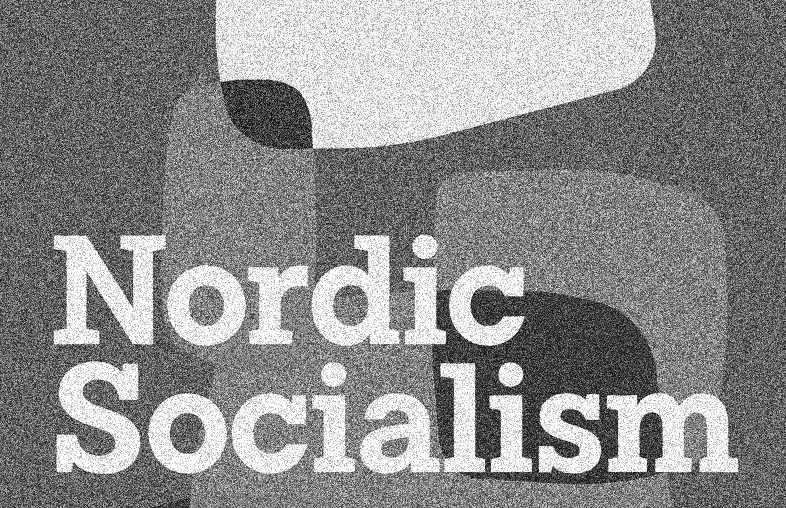Closer Than Mars
A review of Pelle Dragsted’s Nordic Socialism: The Path Toward a Democratic Economy (University of Wisconsin Press, 2025).

What is socialism? That is a question that has broken up many a leftist party, friendship, and I’m guessing somewhere even the odd marriage. Marxists will vary between describing socialism as an aspiration, a transitional phase to full communism, or that which cannot be spoken of without coming dangerously close to writing recipe books for the cook shops of the future. Democratic socialists and social democrats from Eduard Bernstein to Canada’s Ed Broadbent describe socialism in terms of an expansion of freedom and democracy, a break with the bourgeois approach to production, or even a movement of continual transition and improvement. The late Swedish Prime Minister Olaf Palme boasted that Sweden under the Social Democrats had become more socialist than most countries that called themselves such. If Palme had held onto power and the weather was a bit better, perhaps the Swedes would have reformed themselves into a hallowed state of fully automated luxury communism by now.
Accompanying these definitional arguments are equally charged disputes about what countries, if any, can be accurately described as socialist. Just looking at who identifies with the label doesn’t help much. German “National Socialism” liquidated its own socialist and communist parties, and was about as committed to economic democracy as the People’s Republic of North Korea is committed to republicanism. Things get more complicated when pointing to the former Soviet Union or Maoist and then contemporary China. Most socialists now acknowledge the savage brutality of Stalin and Mao and reject any aspiration to emulate their regimes. Plenty are still too quick to apologize for starkly authoritarian practices—for instance by pointing to the Soviet Union’s defeat of the Nazis or the contemporary rise of China to the status of the world’s second power.
In the English speaking world, one of the more interesting debates to flare up recently is whether the Nordic countries (Sweden, Norway, Denmark, Finland, and sometimes Iceland) can be accurately described as socialist. A small cottage industry has emerged introducing and defending the model. This includes popular books like Anu Partanen’s The Nordic Theory of Everything and George Lakey’s Viking Economics: How the Scandinavians Got It Right-and How We Can Too. Self-described democratic socialists like Bernie Sanders and AOC have long identified their aspirations with the Nordic model. Even more ecumenical socialists, like Bhaskar Sunkara in The Socialist Manifesto, dedicate a great deal of time to explaining the rise and plateauing of the model. The attraction is obvious given that, by any metric, the Nordic countries enjoy higher qualities of life and more equality than most any other states on earth.
However, this very appeal has led many on the Right to push back against the characterization of the Nordic states as socialist. Libertarians and conservatives often insist that these countries have robust market economies, and even quite a few billionaires. In a more sinister vein, nationalists on the Right will insist that the Nordic model, even if it were socialist, could not be achieved in culturally diverse and increasingly non-white states like the US—economies of scale be damned. Interestingly they are joined in these reprobations by more than a few socialists and leftists. Marxists like Martin Hagglund stress how even the Nordic states are still defined by wage labor relations, and consequently exploitation. They also highlight how the generous model often depends on integration with the broader capitalist totality, and so participates in the super-exploitation of the developing world.
Reintroducing Nordic Socialism
Pelle Dragsted, a prominent Danish socialist politician, is keen to engage and rebut critics both on the Right and the Left in his lucid Nordic Socialism: The Path Toward a Democratic Economy. It is a welcome contribution to this vital debate, providing one of the most lucid and contemporary discussions of Nordic socialism available.
Dragsted is well aware of global debates about the nature of the Nordic states. He notes with bemusement that many people from the Nordic states themselves seem reticent to embrace their own “model.” Even Finnish-American author Partanen, in her book lauding Finland’s generous approach to solidarity, complains that every
time I hear an American refer to Finland…, I feel like I’ve been suddenly transported back to the 1950s. Finns of my generation and older have a pretty good idea of what socialism is, not to mention communism, having grown up with the Soviet Union right on our doorstep. Our nation fought three brutal wars against socialism in the twentieth century to protect our freedom, independence and free-market system.
None of this stopped Donald Trump’s first administration from publishing a frightening report warning Americans against embracing Bernie Sanders and “Nordic socialism.”
Dragsted argues that rather than rebut these claims by being afraid of the label, Nordic citizens and admirers should embrace it. Referencing Slavoj Žižek, he notes how many in the world feel dispirited that there is “no alternative” to capitalism. This contributes to feelings of hopelessness in the face of the injustice and cresting plutocracy of neoliberalism, and now right-wing populism. Dragsted points to Nordic socialism as an antidote to this depressive mood, being an alternative that is workable, longstanding, and by most metrics a success story that could be emulated. He insists that we “embrace Trump’s concept of Nordic socialism, that we make it our own, that we turn it into a signifier of a new, modern and democratic socialism, inspired by our own experience with socialist ideas that have demonstrated their worthiness throughout our history.”
Part of the particularity of the Nordic model, for Dragsted, is its emergence through historical practice, which was then given ex-post facto theorizations. This has led to difficulties in the conceptualization of Nordic socialism, particularly on the controversial point of what role markets should play. As Dragsted notes, the
social democratic strategy that for all intents and purposes abandoned the goal of socializing ownership of the means of production was based more on direct experience than theoretical considerations. While the theoretical literature of the revolutionary Marxist left is abundant, more theoretically oriented presentations of the social democratic reformist strategy are surprisingly few and far between.
This direct experience nonetheless produced a few key features of the Nordic model: solidaristic welfare programs, markets oriented by prices but heavily democratized, and strong labor movements backed by the state.
Dragsted acknowledges that more might have been possible, but that the Nordic countries’ gains were transformative: chronicling the ascendance of Nordic socialism through the 1970s, he points out that while ownership remained in private hands, “functional socialist reforms” achieved many wins for workers. This included decommodifying enormous swathes of life, from healthcare to education and childrearing. The implementation of solidaristic forms of insurance paid into by all required that each person become invested in the well-being of others as a precondition for their own flourishing. One’s free development became in no small part dependent on the free development of others.
These forms of welfarism and statist redistribution are of course commendable, and one of the reasons that the Nordic states by and large experience higher levels of trust than their Anglo-counterparts. Some conservative critics put the cart before the horse in assuming that level of trust is necessary to implement the model. But in fact, as Francis Sejersted and others note, the Nordic states were often highly stratified and riven by class conflict prior to the twentieth-century socialist transformation. It was reform towards solidarity that built trust, not the other way around.
Still, some socialists might be skeptical that this constitutes the real deal. Statist welfarism is of course very common. But Dragsted insists nonetheless that there is a real novelty in the Nordic model, and that is its radical commitment to economic democratization.
The Virtues of Economic Democracy
For Dragsted, Nordic socialism is defined by four principles: 1) radical democracy, 2) skepticism towards the state, 3) pluralistic ownership, and 4) a combination of markets and planning. Of these, the first is the most important, since a radicalization of democratic principles entails empowering ordinary citizens to have control over the economy in a variety of self-reinforcing ways. Dragsted insists that a
collectively owned and democratically run economy is not a utopian fantasy. It is on the contrary a highly successful reality that for more than a hundred years has been an integral part of our society to the advantage of a broad majority.
By 1899 there were already 1000 consumer co-ops in Denmark. Since then the number has exploded, and expanded to key capitalist sectors such as finance and housing. Dragsted notes that worker-managed cooperatives were initially greeted with some skepticism by statist social democrats, and even some radical leftists, who felt that nationalization was the only appropriate way forward. Statist appropriation and management was of course a hallmark of early and mid-century welfarism, and many were skeptical of the cooperative model. But the virtues became clearer as a vibrant non-capitalist sector emerged which “provided ordinary people with a degree of ownership and democratic influence on a significant part of the larger economy.”
This was not unique to Denmark, as Sweden has more worker cooperatives than its neighbor. Given the surging recent interest in “workplace” democracy on the Left, looking to the cooperative “communal economy” of Nordic socialism seems appropriate. Dragsted notes an additional strength of this model, which is that people’s investment in maintaining the private property rights in communal, cooperative firms has been a barrier to conservative efforts to marketize them.
Another important feature of Nordic socialism is the acknowledgement of political democracy as a necessary but not sufficient condition for human flourishing. Dragsted acknowledges the longstanding Marxist critique of political democracy as a bourgeois sham securing purely formal freedoms, and then more often than not for the few rather than the many. But he insists this is a misnomer, as it is “ironic to conceive of parliamentary democracy, individual rights, universal suffrage, and majority rule as bourgeois given that it was largely the left that led the struggle for such ideals, while the right was typically highly critical of them.” For Dragsted, socialists should be fierce defenders of political democracy while calling for an extension of its principles into the workplace.
Defending the Nordic Model
None of this is to say that the full potential of Nordic socialism was achieved. Dragsted’s core criticism of the model was its failure to inhibit revanchist efforts by capitalism. Part of this is of course not the fault of Nordic socialists, who had to contend with the spread of neoliberalization and the Washington Consensus through the 1980s like many others. The result was the collapse of some of the more ambitious plans for democratizing the economy, such as Rudolf Meidner’s proposal for wage earner funds that would eventually make workers and/or their unions the primary shareholders in the companies they worked for. Much of Dragsted’s positive vision includes reinvigorating the ambition of Nordic socialists and their global counterparts in the present, ideally rolling back the counter-assault of neoliberal capitalists.
The book is limited, however, in perhaps not being sufficiently critical of Nordic socialism’s internal limitations. Dragsted is occasionally too forgiving of the failures of the Nordic Left to sufficiently push back against capital, leaving itself vulnerable to neoliberal retrenchment. In his The Rise and Fall of Swedish Social Democracy, Kjell Östberg is correct to note that by largely ceding questions of ownership to the capitalist class, social democracy left itself very vulnerable to regression when capitalists felt emboldened and threatened by more radical proposals like Meidner’s.
Nevertheless I’ve long felt that socialists allergic to embracing the Nordic model are making a strategic and methodological error. For ordinary people wary of socialism because of its conflation with authoritarianism, pointing to viable and flourishing alternatives is an important way to engage in counter-hegemonic agitation. Especially for vulnerable people who don’t have time to wait for the revolution, pointing to tangible ways socialists have and will materially improve their lives rapidly is important.
But more to the point, I don’t see why one wouldn’t want to learn from the successes of Nordic socialism. This applies even to those on the ultra-left. If I was trying to design a ship that took humanity to Mars, I wouldn’t pooh pooh learning from ship designs that had taken us to the moon. The latter’s success would be both a model for emulation and a starting point to improve upon. In this vital task Dragsted’s Nordic Socialism is helpful. It points backwards to show a way forward for all of us who dream of alternatives better than what the ruling elites insist we accept.
■
Matt McManus is a Lecturer in Political Science at the University of Michigan and the author of The Rise of Postmodern Conservatism and The Political Theory of Liberal Socialism amongst other books.



